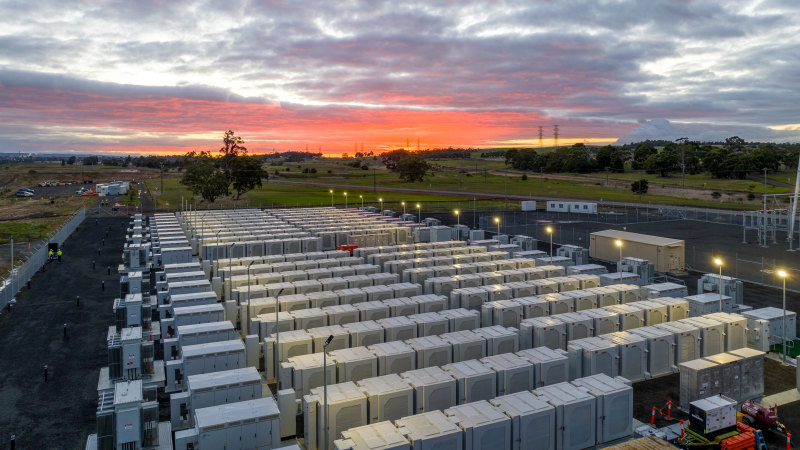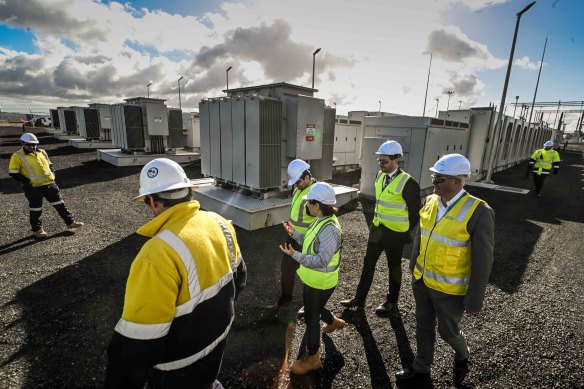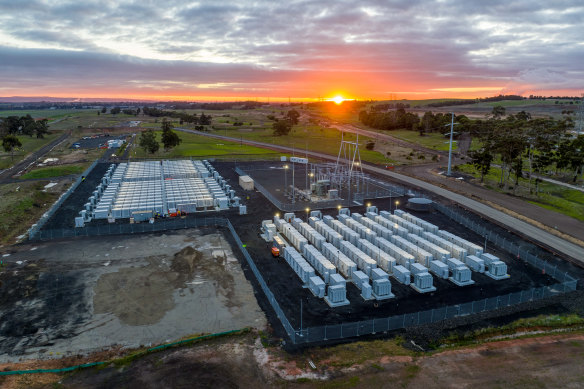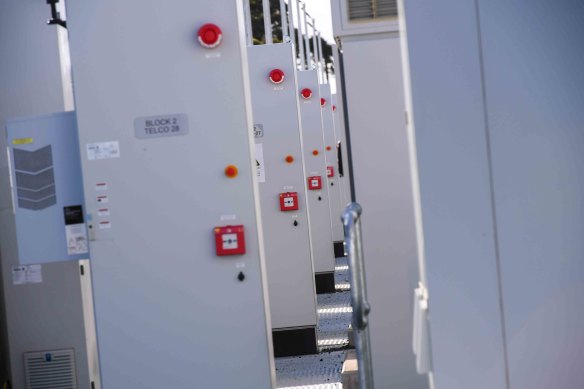Save articles for later
Add articles to your saved list and come back to them any time.
On a hill outside the Latrobe Valley town of Morwell, a cleared site marks the place where the Hazelwood Power Station once stood, its eight chimneys pumping out the brown coal emissions that gave it the unenviable reputation as one of the world’s most polluting power stations.
Today, on the other side of this same hill, a similar site hosts rows of dozens of blocky, modular units that constitute the 150MWh Hazelwood big battery, which has the capacity to power about 75,000 homes for an hour during the evening peak.
Energy minister Lily D’Ambrosio and workers walk around the Hazelwood big battery.Credit: Justin McManus
“The Latrobe Valley has been home to Victoria’s energy generation for decades, and new investment in technologies like energy storage solidify its role in our renewable energy future,” said Victoria’s Minister for Energy, Lily D’Ambrosio, at the official launch of the battery on Wednesday.
Often located next to transmission lines and renewable energy generators, they offer an instant back-up when there is an imbalance in the supply or demand of electricity on the network.
Hazelwood is the first retired coal-fired power station to host a big battery in Australia, and it is also the country’s largest privately funded utility-scale battery, jointly backed by French energy giant Engie, which owns the Hazelwood site, and partners EKU energy and Fluence.
But it’s not as large as some other big battery projects in the pipeline, including the proposed Waratah “Super” Battery at the former Munmorah Power Station in NSW, capable of storing 1400MWh, and a 2000MWh battery for the coal centre of Collie in Western Australia. Both these projects are government-backed.
The Hazelwood battery energy storage system.Credit: Engie
Energy analyst Dylan McConnell, a senior research associate at UNSW, said projects like the Hazelwood battery were much needed, but Australia still wasn’t building enough infrastructure to store and despatch renewable energy quickly.
“The rate at which we are deploying renewable energy and storage is certainly not fast enough – we’re going roughly half as fast as we need to be, in terms of meeting the goals of the government [to generate 82 per cent of power from renewables by 2030],” McConnell said.
He said governments had a key role to play in supporting this investment.
“This explosion of battery projects isn’t going to happen on their own, it’s not just a case of the private sector saving us,” he said. “It’s very much being facilitated by government.”
Without energy storage, such as big batteries or pumped hydro, it is difficult to close coal-fired power plants because they need to be available to produce back-up power when the sun stops shining or the wind stops blowing.
Big batteries offer short-to-medium duration storage (between about one and four hours), while pumped hydro schemes are the only option for long-duration storage – but they are very expensive to build and face considerable environmental and planning hurdles.
Alison Reeve, a climate and energy expert at the Grattan Institute, said Australia’s renewables push faced problems with global supply chains and competition with the European Union and the United States, which have both embarked on large renewables programs.
“Australia is falling down the queue for equipment,” said Reeve. “It’s very ambitious to jump from 30 per cent renewable to 82 per cent by 2030.”
The Hazelwood big battery is just one of dozens that are planned, or already operating, for Australia. Credit: Justin McManus
Federal Climate and Energy Minister Chris Bowen has warned that the construction of transmission infrastructure for new Australian green power remains worryingly slow.
Sharpe told The Australian Financial Review ESG Summit last week that development of crucial infrastructure could be slowed if developers failed to maintain their social license in the rural and regional communities that would bear the brunt of this new infrastructure.
Get to the heart of what’s happening with climate change and the environment. Our fortnightly Environment newsletter brings you the news, the issues and the solutions. Sign up here.
Most Viewed in Environment
From our partners
Source: Read Full Article




